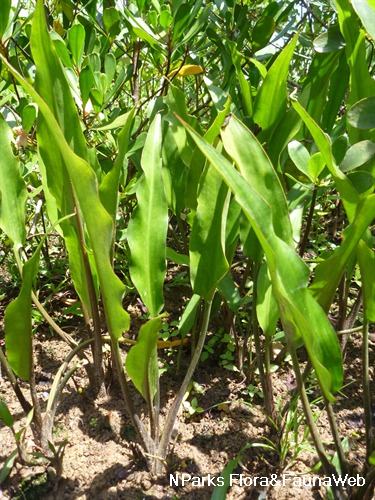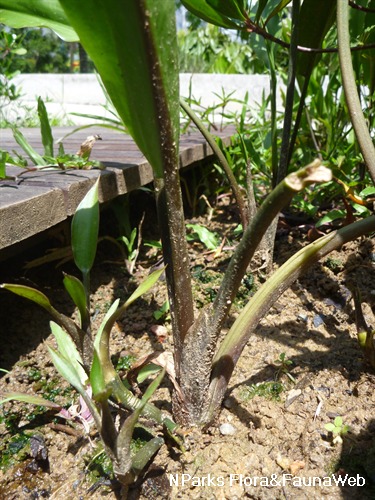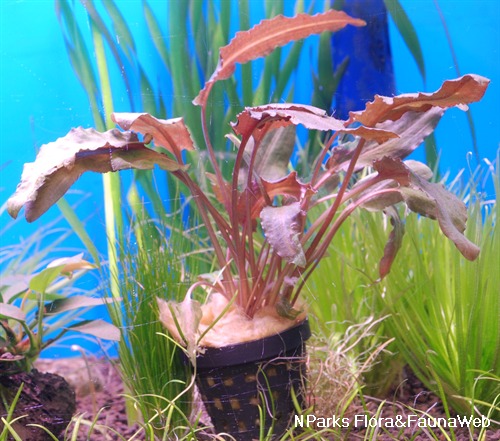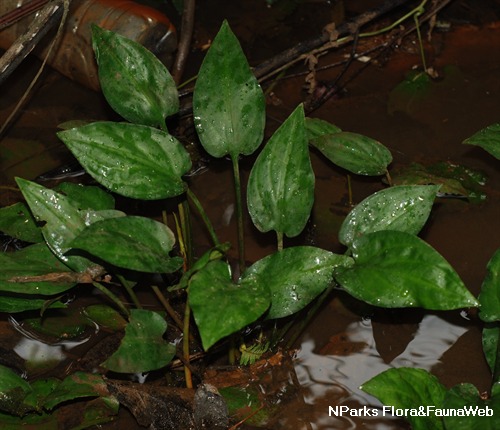
Back
Cryptocoryne ciliata (Roxb.) Fisch. ex Schott
| Family Name: | Araceae |
| Synonyms: | Ambrosina ciliaris Spreng., Ambrosina ciliata Roxburgh, Arum ciliatum (Roxb.) Loudon, Cryptocoryne alata Griff., Cryptocoryne drymorrhisa Zipp. ex Schott |
| Common Name: | Keladi payau, Water trumpet, 绿竹椒草 |
Name
Classifications and Characteristics
| Plant Division | Angiosperms (Flowering Seed Plants) |
|---|---|
| Plant Growth Form | Aquatic & Hydrophyte (Emergent Aquatic, Waterside / Marginal) |
| Lifespan (in Singapore) | Perennial |
| Mode of Nutrition | Autotrophic |
Biogeography
| Native Distribution | Eastern India, Bangladesh, Vietnam, Thailand, Peninsular Malaysia, Singapore, Indonesia, Brunei, and Papua New Guinea |
|---|---|
| Native Habitat | Terrestrial (Freshwater Swamp Forest), Shoreline (Mangrove Forest, Mudflat) |
| Preferred Climate Zone | Tropical |
| Local Conservation Status | Native to Singapore (Extinct (EX)) |
Description and Ethnobotany
| Growth Form | It is a rhizome-bearing herb up to 1 m tall. Its stout rhizome is up to 10 cm long. |
|---|---|
| Foliage | Its alternate, long-stalked leaves possess thinly fleshy, smooth-margined leaf blades that are usually lance- to egg-shaped, and 15–41 by 5–11 cm, with a distinct midrib. Its upright leaf blades are also borne on erect petioles in a rosette. |
| Flowers | The plant produces a tubular structure known as the spathe (a modified leaf that encloses the flowering shoot called the spadix). The spathe takes the form of a tube with a pointed opening at the top. The opening bears purplish-red hairs, and is purplish-red on the outer margin, while the inner margin is greenish-yellow. The rest of the tube is pale-green with purple veins and lines. The swollen base of the spathe is known as the ‘kettle’, and it encloses the spadix, a club-shaped flowering shoot that bears both the male and female flowers. Four to eight female flowers are borne at the base of the spadix, followed by a sterile section and numerous male flowers on the apical end. Its flowers are without petals. |
| Fruit | Its black fruits are round, fleshy, 2.5–3 cm long, and break open into six to eight parts when ripe to release tiny seedlings. Its seeds are smooth and whitish. |
| Habitat | It grows semi-submerged or fully exposed in wet, muddy areas and tidal streams of coastal vegetation, often in nipah palm (Nypa fruticans) stands in mangrove forests and occasionally in freshwater swamps. |
| Associated Fauna | Its flowers are insect-pollinated. |
| Cultivation | It can be propagated by seed, and cuttings of the rhizomes. |
| Etymology | Greek crypto, hidden; Greek coryne, club, referring to the hidden spadix (flowering shoot that is associated with a large modified leaf at its base, the spathe that encloses the flowering shoot); Latin ciliata, ciliate or fringed with hairs, referring to the purplish-red hairs on the spathe of this species |
Landscaping Features
| Landscaping | It is suitable for planting along the margins of freshwater or brackish waterways or water bodies in stands for its lush attractive foliage, and unique purplish-red, hairy spathes. |
|---|---|
| Desirable Plant Features | Ornamental Flowers, Ornamental Foliage |
| Landscape Uses | Coastal, Beachfront / Shoreline, Riverine, Pond / Lake / River, Marsh / Bog, Aquarium / Aquascape |
| Thematic Landscaping | Water Garden, Marsh Garden |
Fauna, Pollination and Dispersal
| Pollination Method(s) | Biotic (Fauna) |
|---|---|
| Seed or Spore Dispersal | Abiotic (Water) |
Plant Care and Propagation
| Light Preference | Full Sun, Semi-Shade, Full Shade |
|---|---|
| Water Preference | Lots of Water |
| Plant Growth Rate | Moderate |
| Rootzone Tolerance | Waterlogged Soils (Does not Drain Site), Saline Soils / Salt Spray, Shallow Media, Easy to Grow |
| Transplanting Tolerance | Good |
| Maintenance Requirements | Low |
| Propagation Method | Seed, Division |
Foliar
| Foliage Retention | Evergreen |
|---|---|
| Mature Foliage Colour(s) | Green |
| Mature Foliage Texture(s) | Leathery |
| Foliar Type | Simple / Unifoliate |
| Foliar Arrangement Along Stem | Alternate, Rosulate / Rosette |
| Foliar Attachment to Stem | Petiolate |
| Foliar Shape(s) | Non-Palm Foliage (Lanceolate, Elliptical) |
| Foliar Venation | Parallel |
| Foliar Margin | Entire |
Floral (Angiosperm)
| Flower & Plant Sexuality | Unisexual Flowers , Monoecious |
| Flower Grouping | Cluster / Inflorescence |
|---|
| Flower Location | Terminal |
| Inflorescence Type | Spathe & Spadix |
Fruit, Seed and Spore
| Mature Fruit Colour(s) | Black |
|---|---|
| Fruit Type | Fleshy Fruit , Non-Accessory Fruit |
Image Repository
Others
| Master ID | 31194 |
|---|---|
| Species ID | 5588 |
| Flora Disclaimer | The information in this website has been compiled from reliable sources, such as reference works on medicinal plants. It is not a substitute for medical advice or treatment and NParks does not purport to provide any medical advice. Readers should always consult his/her physician before using or consuming a plant for medicinal purposes. |




